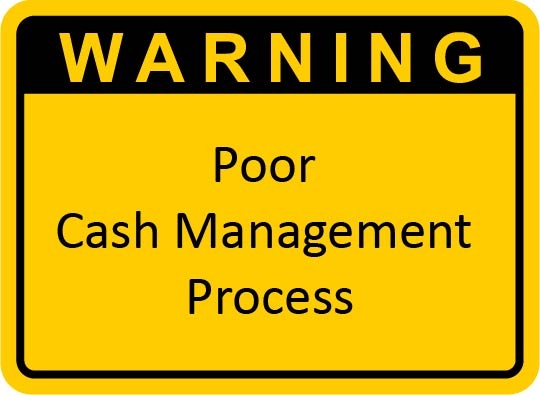Most retail operations and branch managers at banks and credit unions believe that they are doing a good job of managing cash. While they may admit to some room for improvement (nobody’s perfect, right?!), many don’t believe that tweaking their branch cash management practices would significantly improve the branch’s operations or profitability. As a result, many branches operate under the myth that they are doing a good job of managing cash. However, here are five warning signs that might reveal poor branch cash management practices at the branch level.
Warning Sign #1. Branches Asking For Emergency Shipments
Emergency shipments are shipments and orders of cash outside the set schedule of cash deliveries. Bank and credit union branches request emergency shipments when they miss an order deadline or they run out of cash between scheduled delivery cycles, especially when the next scheduled delivery date is still days away. While one-off emergency shipments might happen if customers occasionally come in with large requests for cash that are unplanned and not representative of their historical withdrawal patterns, more frequent emergency shipments are definitely a red flag!
The use of frequent emergency shipments signals that the branch:
- May not have a good handle on its cash needs
- May not carry enough cash on hand
- And, more specifically, may not have the right mix of denominations to meet customer needs.
Additionally, emergency shipments also signal that management may have set a cash limit that’s too low relative to the branch’s higher outflow needs.
Warning Sign #2. Branches Borrowing Denominations from Other Branches
Another warning sign of poor branch cash management is if branches frequently borrow denominations, which they’ve run out of before their scheduled cash delivery date, from other branches. Inter-branch cash borrowings are an easier way to gain cash because they do not cost extra and do not require a money supplier and/or armored car. These types of transfers often work on tacit agreements and the buddy system between branch managers, with transfers happening without bank executives getting a whiff of them.
Moreover, cash in ad hoc inter-branch transfers is usually transferred by branch staff using personal cars, without security or insurance, and poses greater risk of robbery and related injury. In addition to these risks, such transfers signal that a branch does not keep track of, analyze, or understand its customers’ cash usage patterns and is, therefore, unable to keep the right denominations and quantities of cash in-branch for its customers.
Warning Sign #3. Cash Orders are Standard Amounts, Disconnected from Amount Dispensed
ATM managers or branch managers (in the case of in-wall ATMs at a branch) who do not track and analyze cash withdrawals and are not focused on optimizing cash in ATMs, consequently place Standard Orders for ATM cash. An example of a Standard Order is where cash delivery companies alway top-up ATMs to maximum capacity, irrespective of ATM usage.
Say an ATM holds $200,000 (max capacity) and, typically, vends out $50,000 between routine scheduled deliveries (say every Monday). If the manager of this ATM has standing instructions to fill the ATM back up to $200,000 at every scheduled delivery, the bank or credit union ends up with at least $150,000 in idle cash sitting at this ATM every day – money that represents a wasted opportunity because it isn’t being used to generate income for the bank.
If the abovementioned ATM is at a location that is difficult to deliver to - making it more costly to frequently ship cash to the ATM than the investment opportunity of that excess cash - the ATM manager should keep standard top-up orders in place but change the delivery schedule to fewer deliveries (perhaps to once every 2-4 weeks) so the bank cumulatively saves substantial amounts through fewer armored-car cash deliveries across its network of ATMs.
Warning Sign #4. Armored Car Cash Delivery Schedule Same as 10 Years Ago
With little appetite for borrowing after the banking collapse of 2008, many banks may have reduced their armored car schedules because maintaining excess cash levels was less expensive than the cost of deliveries. But now, times have changed.
With interest rates almost certainly set to rise in 2018 and beyond, and with an upsurge in borrowing activity by individuals and businesses keen to lock-in low rates before they rise, this is a good time for banks and credit unions to review their armored car delivery schedules. Here’s why:
Sticking with our ATM example:
Why have $150,000 idling in an ATM when that money can be loaned at attractive rates of interest and earn far more than the cost savings from fewer armored car deliveries??
In a rising interest rate and healthy lending environment, it no longer makes sense to have excess cash idling in ATMs and other cash locations. Instead, banks and credit unions must optimize cash at all withdrawal locations and actively invest all available cash, even if that means upping the number of armored car cash deliveries (from, say, once every two weeks to once weekly).
On the flip side, cash demands on a branch change every year. A high demand branch might need to upgrade from one delivery to two deliveries per week over a year’s time. So, armored car schedules, which are typically multi-year contracts, should not be set-it-and-forget-it but should be reviewed periodically for delivery schedule changes, especially when it is time to negotiate a new contract.
Warning Sign #5. Branch Limits Are Static
Banks and credit unions set limits as the most common way to manage cash levels. These limits are typically based on insurance and risk tolerance, but have little or no connection to customers’ actual usage of cash.
Per good branch cash management practices, a limit should never be set without considering usage. Branch cash demands are fluid and fluctuate throughout the year. For instance, a branch might exceed its limit when demand for cash is high, say at the end of a pay period, around holidays, back-to-school days, etc.
Additionally, a static limit might restrict a branch manager from properly serving customer needs and damage the bank’s reputation within the community it serves, if the branch continually runs out of cash because it isn’t allowed to order amounts above an arbitrary limit. As with armored car deliveries, cash limits should not be set-it-and-forget-it but should be reviewed and adjusted on a quarterly basis to factor-in high/low cash usage patterns.
So… do you hear any warning bells going off for your branch??
There's a lot at play when it comes to branch cash management. Check out our video, "Just a Normal Cash Day," to see why.

